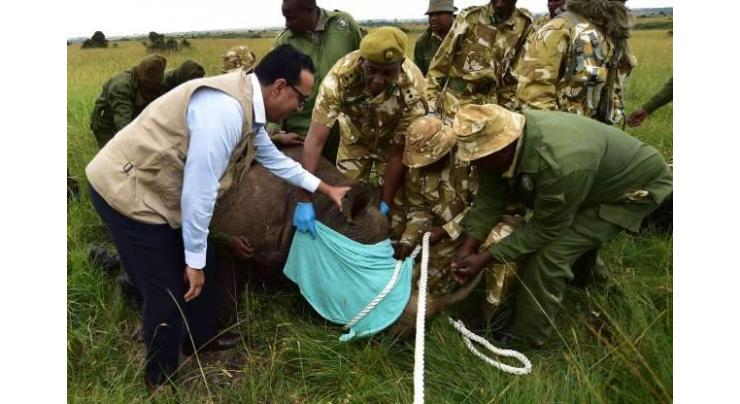
How A Plan To Save Kenya's Rhino Left 11 Dead In Historic Blunder
Rukhshan Mir (@rukhshanmir) Published August 30, 2018 | 11:53 AM

It was a disaster that left wildlife lovers around the globe appalled and baffled.
Nairobi, (APP - UrduPoint / Pakistan Point News - 30th Aug, 2018 ) :It was a disaster that left wildlife lovers around the globe appalled and baffled.
Eleven of Kenya's precious black rhinos were transferred to a new home in what was supposed to be a routine operation in a country fabled for its conservation.
So how did all of them end up dead? The Primary cause of death, an official report found, was due to toxic levels of salt in the water of their sanctuary.
But an AFP investigation has found that the problem was well known and deep concerns were ignored.
Experts sounded repeated warnings about the site's unsuitability.
Yet the relocation project was pushed through -- and officials are now blaming each other for the fiasco.
The translocation was launched with great fanfare in late June by Kenya's tourism and wildlife minister, Najib Balala, and the World Wildlife Fund (WWF), which donated a million Dollars (860,000 Euros) for the project.
Dubbed #TheBigMove, the operation would help ensure the survival of a species brutally depleted by poaching.
The International Union for Conservation of Nature (IUCN) describes the black rhinoceros (Diceros bicornis) as Critically Endangered -- just one step away from being extinct in the wild.
Rhino from parks in Nairobi and Nakuru were sedated, loaded and transported to a new sanctuary in Tsavo East, a project that the Kenya Wildlife Service (KWS) and WWF had spent six years preparing.
There, the rhino drank borehole water so salty that it corroded a metal grill around the pump valve, and no other wildlife would come near it, said Dr Benson Kibore, head of Kenya's Union of Veterinary Practitioners.
The saline water made the animals only thirstier, pushing them to drink more, drawing water out of their body tissue, thickening and slowing their blood. They were "dessicated", said Kibore.
A rhino named Bolt was the first to die, and the others soon followed.
The last, Jack, was so weakened he could not fend off a lion attack that left him wobbling and alone, with huge gashes in his side before he succumbed days later.
"I was horrified. I was very certain there was going to be a very big problem with those rhinos," said Nehemiah Rotich, a veteran conservationist and former KWS chairman.
At the time of the translocation, he was chief operating officer but had been tasked by the KWS board with looking closely into the project.
Rotich and some former members of the board -- the oversight body which has to approve major management decisions -- said they had blocked the transfer multiple times due to fears about the saline borehole water and the lack of vegetation.
"The site chosen wasn't a good one," Rotich told AFP. He visited it twice, arguing it was too arid and far from a river, requiring the drilling of two boreholes.
Discord came to a head in 2016, former board member Brian Heath said.
The board were told with just days' notice that a big ceremony was planned by KWS and the WWF to launch the transfer, just as a punishing drought was taking hold, he said.
"We said, 'No way!'" he recalled.
But pressure persisted, he said.
Both Heath and Rotich accused the WWF of "pushing hard" for the translocation. Their anger was echoed last week by prominent conservationist and former KWS chair Richard Leakey, who in a parliamentary submission slammed the WWF for "interference." In October 2017, the board gave conditional approval for the translocation pending improved conditions at the site.
The board's mandate expired in April 2018.
By that time, the green light for the translocation had still not been given to the management.
Even so, the operation went ahead three months later -- in the absence of a new board.
Related Topics
Recent Stories

Rock-solid Ruud racks up season-leading win in Barcelona

At UN, Iran says it will make Israel 'regret' reprisals

G7 hears calls for 'critical' Ukraine aid

EU seeks to leverage might to confront China, US challenge

5 Customs officials martyred as their vehicle ambushed by terrorists in D I Khan

Pak-New Zealand match called off due to rain

NHA restores traffic on roads affected by recent rains in Balochistan

China to fully support Pakistan's efforts against terrorism: Ambassador Jiang

U.S. envoy calls on Foreign Minister Ishaq Dar

Poland arrests man over suspected plan to kill Zelensky

EU wants to ease youth movement to and from UK

Police foils attempt of supply mainpuri raw material
More Stories From World
-
At G7, Blinken seeks European support for pressure on China
3 hours ago -
Thousands of Bosnian Serbs rally against UN resolution on Srebrenica
3 hours ago -
Israel assault has turned Gaza into 'humanitarian hellscape': UN
4 hours ago -
Husband of ex-Scottish leader charged over alleged embezzlement: police
4 hours ago -
Ecuador hit by power cuts of up to 13 hours amid drought
5 hours ago -
Hugs or bullets? How Mexico presidential rivals aim to curb violence
5 hours ago
-
Kenya military chopper crash kills defence chief, senior officers
5 hours ago -
Biden hails 'incredible' Kennedy family backing against RFK Jr.
5 hours ago -
Maldives court frees jailed ex-president ahead of vote
6 hours ago -
Probe into Portugal ex-PM Costa appears to collapse
6 hours ago -
Jury selection stalls in Trump criminal trial
6 hours ago -

At UN, Iran says it will make Israel 'regret' reprisals
6 hours ago
